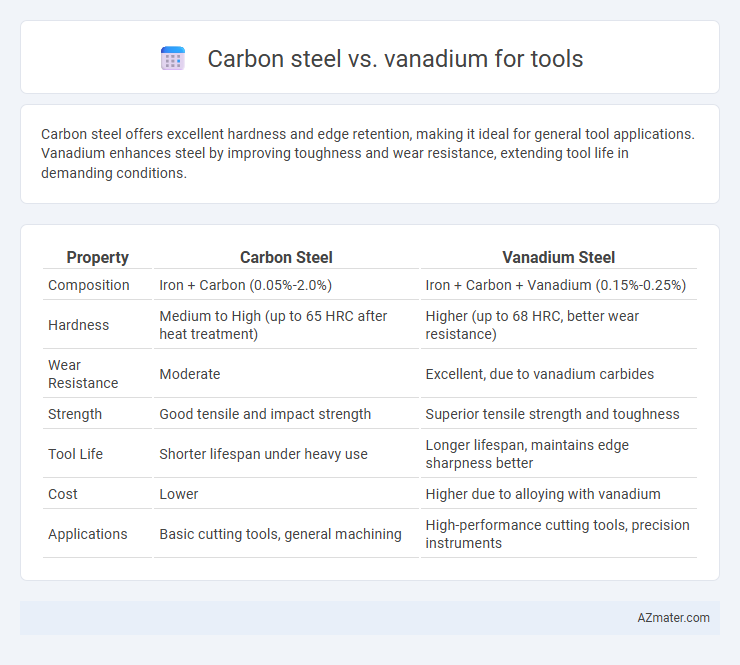Carbon steel offers excellent hardness and edge retention, making it ideal for general tool applications. Vanadium enhances steel by improving toughness and wear resistance, extending tool life in demanding conditions.
Table of Comparison
| Property | Carbon Steel | Vanadium Steel |
|---|---|---|
| Composition | Iron + Carbon (0.05%-2.0%) | Iron + Carbon + Vanadium (0.15%-0.25%) |
| Hardness | Medium to High (up to 65 HRC after heat treatment) | Higher (up to 68 HRC, better wear resistance) |
| Wear Resistance | Moderate | Excellent, due to vanadium carbides |
| Strength | Good tensile and impact strength | Superior tensile strength and toughness |
| Tool Life | Shorter lifespan under heavy use | Longer lifespan, maintains edge sharpness better |
| Cost | Lower | Higher due to alloying with vanadium |
| Applications | Basic cutting tools, general machining | High-performance cutting tools, precision instruments |
Introduction to Carbon Steel and Vanadium in Toolmaking
Carbon steel is widely used in toolmaking due to its high strength, durability, and ease of heat treatment, offering reliable hardness and wear resistance for cutting and shaping applications. Vanadium, often added as an alloying element or used in vanadium steel, enhances tool performance by increasing toughness, wear resistance, and refining grain structure, which improves overall durability and edge retention. The combination of carbon steel with vanadium results in superior tool materials that balance hardness and toughness, making them ideal for heavy-duty and precision tool applications.
Composition and Key Properties of Carbon Steel
Carbon steel primarily consists of iron and carbon, with carbon content typically ranging from 0.05% to 2.0%, which directly influences its hardness and strength. The microstructure of carbon steel includes pearlite, ferrite, and cementite, providing excellent wear resistance and ease of machining, making it a popular choice for general-purpose tools. Unlike vanadium-enhanced steels, carbon steel lacks significant alloying elements like vanadium that improve toughness and heat resistance but remains cost-effective and versatile for cutting and shaping applications.
Vanadium: Characteristics and Metallurgical Benefits
Vanadium enhances tool steel by improving hardness, wear resistance, and toughness due to its ability to refine grain structure and form stable carbides. Compared to carbon steel, vanadium-alloyed tool steels offer superior strength retention at high temperatures, making them ideal for demanding cutting and shaping applications. Its metallurgical benefits include increased fatigue resistance and improved overall durability, resulting in longer tool life and reduced maintenance costs.
Hardness and Strength Comparison
Carbon steel tools typically exhibit hardness levels ranging from 55 to 65 HRC, offering substantial strength for general applications due to their carbon content, while vanadium-alloyed tools often achieve higher hardness levels up to 67 HRC as a result of vanadium's grain refinement and carbide formation properties. The presence of vanadium enhances tensile strength and wear resistance, improving cutting edge retention and impact resistance compared to carbon steel. Tool steels with vanadium exhibit superior toughness and durability, making them preferable for high-performance cutting and heavy-duty machining tasks.
Wear and Corrosion Resistance
Carbon steel offers moderate wear resistance due to its higher carbon content but tends to corrode faster when exposed to moisture or acidic environments. Vanadium-enhanced steel significantly improves wear resistance by forming hard vanadium carbides, which increase hardness and retain sharp edges longer. Corrosion resistance in vanadium alloys is also superior, as vanadium promotes the formation of a protective oxide layer, reducing oxidation and extending tool lifespan.
Edge Retention and Sharpness Performance
Carbon steel tools offer excellent edge retention due to their high carbon content, allowing for a harder, sharper cutting edge that maintains sharpness through repetitive use. Vanadium, as an alloying element in steel, enhances grain refinement and wear resistance, significantly improving edge sharpness and durability by preventing micro-chipping and corrosion. Tools with vanadium-enriched steel often outperform plain carbon steel by maintaining a sharper edge longer under heavy-duty and precision applications.
Workability and Ease of Sharpening
Carbon steel exhibits excellent workability due to its softer composition, allowing easier shaping and manipulation during tool manufacturing. Vanadium, often alloyed with steel for enhanced strength and wear resistance, can complicate sharpening because its toughness requires more effort and specialized tools to maintain a fine edge. Tools made from carbon steel are preferred for ease of sharpening and quick maintenance, while vanadium-alloyed tools deliver durability but may demand professional sharpening for optimal performance.
Cost and Availability Considerations
Carbon steel tools generally offer lower initial costs and higher availability due to widespread production and simpler manufacturing processes, making them suitable for budget-conscious applications. Vanadium alloyed tools, while more expensive upfront, provide superior hardness, wear resistance, and durability, resulting in longer tool life and reduced replacement frequency. The cost-benefit balance favors carbon steel for general-purpose tools but leans toward vanadium alloys in high-performance or heavy-duty industrial environments where tool longevity justifies the price.
Best Applications for Carbon Steel vs Vanadium Tools
Carbon steel tools excel in applications requiring high hardness and edge retention, such as woodworking chisels and cutting tools, due to their excellent wear resistance and ease of sharpening. Vanadium tools are preferred for heavy-duty industrial applications, including impact tools and high-stress cutting environments, because of vanadium's ability to enhance toughness, reduce grain size, and improve resistance to wear and fatigue. Choosing between carbon steel and vanadium tools depends on the specific demands of the task, with carbon steel favored for precision and vanadium for durability and strength under extreme conditions.
Choosing the Right Material: Which Suits Your Needs?
Carbon steel offers excellent hardness and edge retention, making it ideal for tools requiring sharpness and durability, while vanadium steel enhances toughness and wear resistance due to its superior alloy composition. Selecting carbon steel suits applications demanding high strength and ease of sharpening, whereas vanadium alloys are preferable for tools exposed to heavy impact and sustained use. Understanding the balance between hardness, toughness, and corrosion resistance helps determine the optimal material based on specific tool functions and environmental conditions.

Infographic: Carbon steel vs Vanadium for Tool
 azmater.com
azmater.com